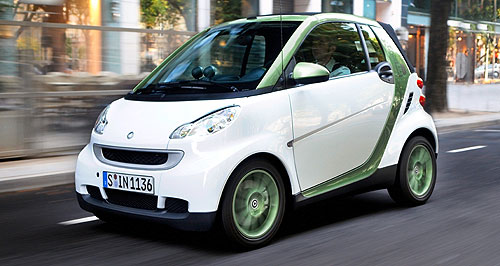Future models - Smart - ForTwo - EVFirst look: Smart shows MkII ForTwo EVOn trial: Smart's electric ForTwo costs just $3.40 to charge. Smart reveals second-generation ForTwo electric drive for lease in Europe and US24 Aug 2009 THE all-electric version of Daimler’s new Smart ForTwo has been revealed in Germany, ahead of limited production for rental customers in selected European and US cities from mid-November. Yet to be confirmed for right-hand drive production, the MkII electric Smart initially will be available only for lease to customers in progressive cities led by Berlin, before full-scale availability from 2012. The plug-in ForTwo will be built at the Smart factory at Hambach, in France, and is yet to be confirmed for release in Australia, but Daimler chairman Dieter Zetsche said during a visit to Sydney last August that it would be made available to Australians. The newest Smart is a fully electric vehicle (EV) rather than a ‘mild hybrid’ like the ForTwo “micro hybrid drive”, which effectively made idle-stop technology standard in the 52kW non-turbocharged ForTwo Coupe and Cabriolet from last December. Priced from $19,990, more than 80 examples of the ForTwo MHD have been sold here. However, the groundbreaking two-seater EV promises to be more inventive than both the MHD, the 100 trial examples of the previous-generation Smart EV and its unimaginative title (“smart fortwo electric drive”), thanks to a 14kWh lithium-ion battery supplied by EV partner Tesla Motors. Fitted between the axles of the second-generation Smart ForTwo, which has been on sale Australia since March 2008, the Li-Ion battery powers a rear-mounted 30kW magneto-electric motor delivering 120Nm of instantaneous torque.  Even better, it says the ForTwo EV accelerates to 60km/h in the same 6.5 seconds as its petrol-powered equivalent, has a driving range of about 115km, costs just €2 ($A3.41) to fully recharge from a regular household power outlet in Germany – and even cheaper using off-peak rates. Even better, it says the ForTwo EV accelerates to 60km/h in the same 6.5 seconds as its petrol-powered equivalent, has a driving range of about 115km, costs just €2 ($A3.41) to fully recharge from a regular household power outlet in Germany – and even cheaper using off-peak rates.For the average 30-40km that Daimler says studies reveal covers most daily commuting roles, the battery needs to be charged for only three hours. Revealed in 2008 following Daimler’s purchase of a stake in US electric sportscar maker Tesla, the zero-emissions Smart is claimed to offer the same luggage and passenger space as the 2.5-metre-long two-seater upon which it is based because the battery replaces the fuel tank under the floor. Top speed is limited to 100km/h, which Daimler says is “a suitable speed for the city”, and is attained via a single fixed gear ratio that negates the need for gear-changes. To reverse, the engine’s direction of rotation changes. To become available in both coupe and cabrio guise, the new Smart EV matches the Toyota Prius’ ability to operate its air-conditioning system while stationary. Apart from a battery indicator, an ammeter shows the level of consumption and recuperated energy. Unlike the first-generation ForTwo EV, its successor is claimed to offer the same advantages of other Li-Ion battery-powered vehicles, including higher performance, shorter charging times, longer battery life and greater durability. It will become available to “selected leasing customers” for a period of four years and 60,000km, with the first examples bound for Germany’s “e-mobility Berlin” project, in which energy company RWE, the German government and the city of Berlin will create “a network of electricity charging stations that enable intelligent communication between electric vehicles and the power network so that the battery can be charged when electricity is cheapest”. The ForTwo EV will then be made available to customers in Hamburg, Paris, Rome, Milan, Pisa and Madrid, plus some unspecified US cites, before being mass-produced and sold alongside the petrol-powered ForTwo globally from 2012. “The second-generation Smart ForTwo Electric Drive is based on a successful and accepted vehicle concept with character and inherent environmentally friendly characteristics,” said Smart brand manager Marc Langenbrinck. “Its innovative electric battery drive makes it the perfect car for the city: it is agile, economical and climate-friendly. Motoring with zero local emissions in an urban environment has become a reality. This equates to driving fun with a clear conscience.”  Read more |
Click to shareSmart modelsResearch Smart Motor industry news |

















Facebook Twitter Instagram